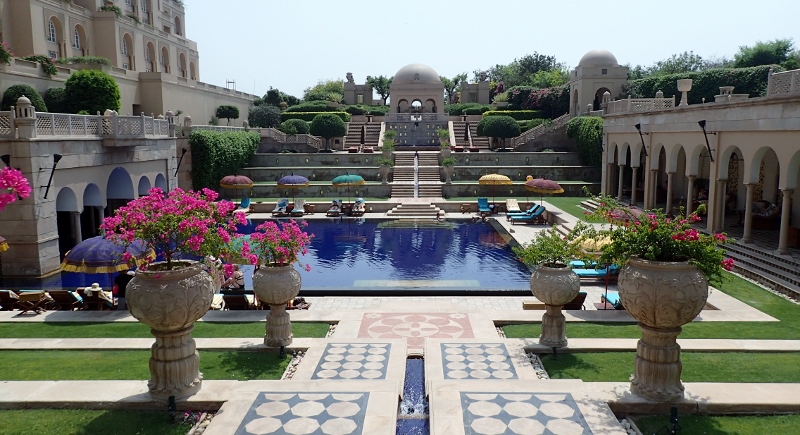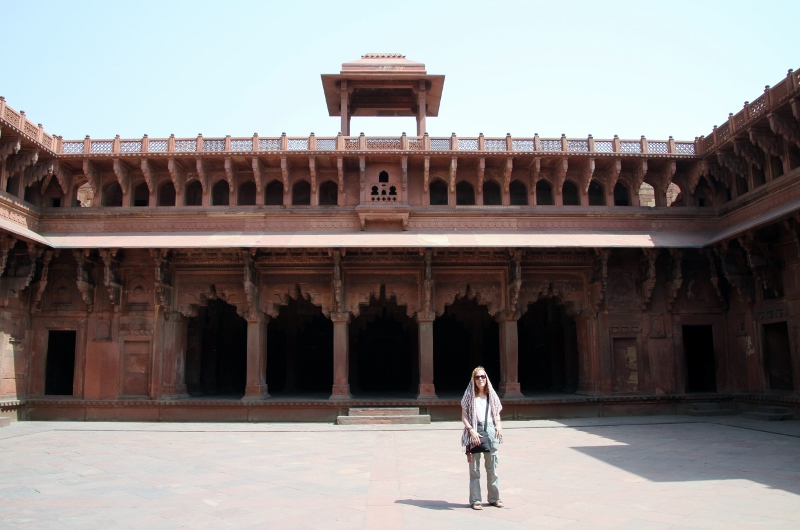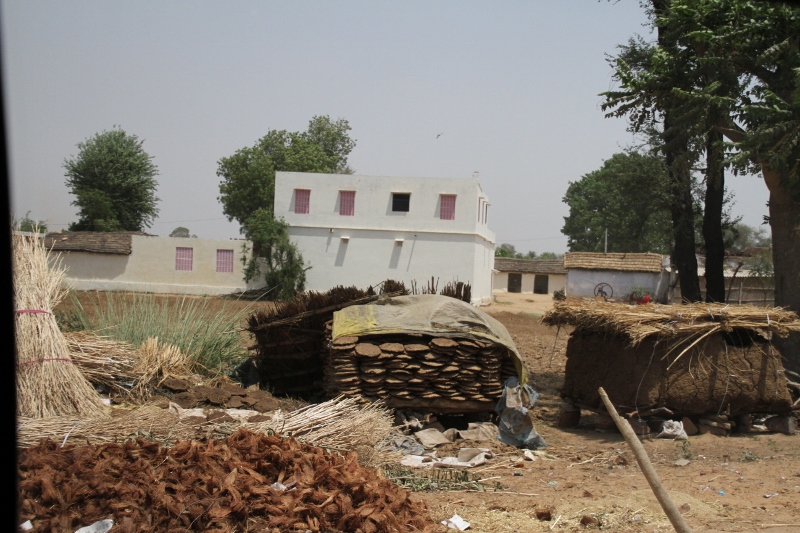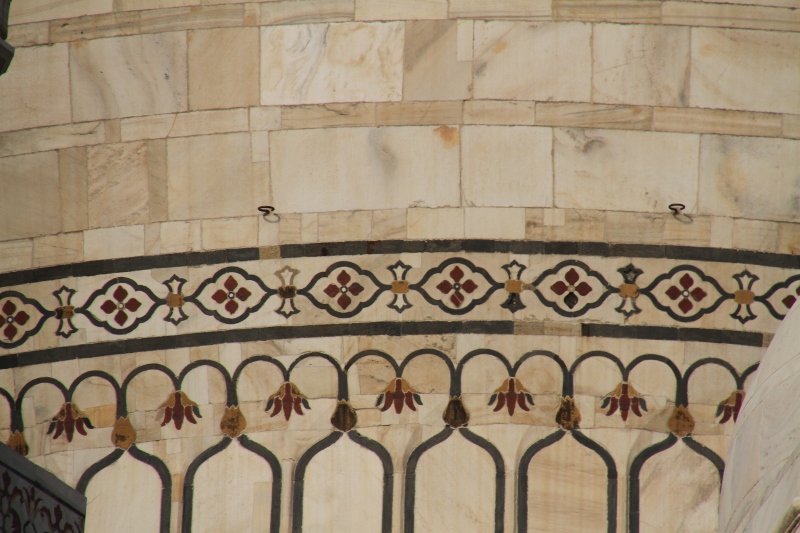Agra is home of the Taj Mahal, the mausoleum built by Shah Jahan for his beloved wife who died in childbirth. If anything is iconic as a symbol of India it is this one building. But as we found out, there is more to Agra than just the Taj.
We left Delhi about 9:30 driving to Agra. Along the way we passed many fields and villages and V explained many of the customs and living conditions of people in the countryside. We noticed grass sheds and piles of what looked like dirt. The sheds were for storing grass to feed the cattle during the dry season. The other piles were dung that would be dried and mixed with straw to make patties to burn for heat and cooking.
We also passed many smoke stacks which were kilns for making bricks. The local people form the bricks by hand. They are dried in the sun and then taken to the kiln for firing.
We arrived at our hotel around 12:30. With temperatures of 104, we decided to rest and relax by the pool for the afternoon and go out in the evening.

The hotel reminded of our Anniversary. 
The pool, something out of Arabian Nights. 
The view from our room.
Our first stop this evening was at the tomb of I’timad-ud-Daulah. Built between 1622 and 1628 it represents a transition between the first phase of Mughal architecture – primarily built from red sandstone with marble decorations, as in Humayun’s Tomb – to a second phase, based on white marble and pietra dura inlay (floral design made up of semiprecious stone) most elegantly realized in the Taj Mahal. The tomb is also referred to as the “Baby Taj”.

The gate 
Side view 
All the stone inlay 
The tombs 
The dome over the tombs 
The Garden 
Before sunset we entered gardens across the river from the Taj Mahal. These gardens were recently reclaimed and offer a view of the Taj that encompasses the side buildings that cannot be seen from the front gate. The building on the right is a mosque. Because in Islamic construction symmetry is important, a second building had to be built on the other side that mimicked the Mosque. This building actually served no purpose, other than to maintain the symmetry of the construction.

Then it was back to the hotel.
April 24 A visit to the Taj Mahal and the Red Fort
We left the hotel early, 6:00AM to beat the rush at the Taj and the heat. The Taj Mahal is designed to be the perfect symmetrical structure. It is regarded as the best example of Mughal architecture. It was commission by Shah Jahan in 1631 to be built in memory of his favorite wife Mumtaz Mahal, a Persian princess who died giving birth to their 14th child. It is also the tomb of Shah Jahan. It was constructed on the banks of the Yamuna river and is surrounded on three sides by formal gardens and a crenelated wall.


The mosque
Of course, Cathy had to recreate a picture on the “Diana” bench when she was here twenty years ago with two colleagues who, alas, did not make this trip.

Note the detail of the decorations. These are not painted on. Every one is stone inlay made with semi-precious stones. The technique was perfected in Persia and the workmen were brought from there to work on the construction. Their decedents still reside in Agra and are still practicing this almost lost craft.
As you look at the pictures of the Taj, you notice that the towers around it lean out, away from the tomb. This is not an optical illusion; they were built that way. While India does not experience earth quakes, the builders were from Persia where they were not uncommon, so the towers are built so that in the event of an earth quake, they will fall away from the tomb.

But why have the towers? They give the tomb perspective. Consider that the tomb is 10 meters taller than the Qutub Minar in Delhi, yet it does not look like it, because of the towers around it make it squarer, that is more symmetrical.
Since his wife’s tomb lies directly in the center of the building, ironically, it is the tomb of Shah Jahan along side his wife, that destroys the symmetry of the complex.
Our next stop was at the Red Fort. This was the main residence of the Mughal emperors until 1638 when the capital was shifted from Agra to Delhi. From here, Shah Jahan could watch the construction of the Taj Mahal, and from the balcony he could look out on it, while in captivity after being deposed by his son. It is on this balcony it is believed he died.

Entrance to the fort. 
The Queen’s rooms. 
The kings rooms. 
Restored section of the ceiling 
The bath tub, with fountains. Seats for a lot of friends. 
The King’s daughters room, next to the king’s. 
The harem 
Is she leaving or going to the harem? 
The “house of commons” 

The balcony where he could see the Taj.
Testimony to the presence of the British in India is a grave of John Russell Colvin who was the Lieutenant-governor of the North-West Provinces of India. In 1857, at the start of the mutiny (what we know as the Sepoy mutiny), Colvin was at Agra with only a weak British regiment and a native battery. Accounts of the cause of his death vary from receiving the first bullet in the mutiny to cholera. Because of the wide spread revolt, it was not possible to take his body out of the fort, so the company decided to bury him in the Agra fort complex.

Following our visit to the fort we stopped at a shop where the decedents of the Persian stone cutters still practice the same art of their ancestors using hand tools and semi-precious stones inlay in marble.

Etching out the place for the stones 
Cutting and shaping each stone by hand 
The pieces have to fit perfectly. 
64 different pieces for a single flower 
See how small they are.










Better than Nat Geo Howard!!